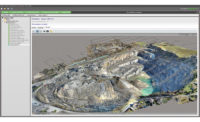Social media, mobile devices, apps and drones are finding new roles helping stakeholders—such as construction companies and their personnel and jobsites—who have assets at risk when they confront shifting disasters, such as hurricanes and wildfires.
One app developer, Sam Lanier, CEO of FireWhat Inc., has just released a platform, called Incident Dashboard, that mashes up data feeds about advancing wildfires onto a map display. It is designed to keep first-responders and the public informed about evolving firefighting events. He says “tons of contractors” typically spring into action for wildfires to supply equipment in support of firefighting teams on the front lines.
Lanier says his tool soon will be adapted to handle evolving information about advancing threats from other natural threats, such as hurricanes.
“The application gets a live feed from everyone in the field and gives us minute-by-minute updates,” says Lanier, who worked as a fire chief for 15 years before he created the app.
Incident Dashboard works like the traffic app Waze, says Lanier. As online users see events, they push out live reports, with locations tagged to the interactive map, sending instantaneous updates to the public at large. “They drop a point on the map and publish updates that tell things like where a power line is down, where we need animal control or a school needs an evacuation,” says Lanier.
The map-based display is an improvement on earlier tools, with which firefighters exchanged wildfire updates via text messages. He says the information wasn’t easily consumable, so he partnered with Esri, a mapping and spatial data-analysis company, to include the wildfire data in an interactive map.
When the app is adapted for hurricane response, it should fit well in the toolbox of contractors such as Scott Gerard, vice president for environmental, health and safety at Moss & Associates, Fort Lauderdale. Gerard is leveraging technology he already has to prepare for hurricanes.
“Our IT team helped develop an emergency texting list. It lets us easily send an emergency text alert to our entire safety team and operational leaders,” says Gerard, who shared ideas about tools and technologies for hurricane prevention in a recent op-ed piece on ENR.com.
He says one particularly valuable disaster tool is tied to the proliferation of high-quality video cameras on mobile devices. In the event of a possible hurricane strike, one of his team’s first tasks is “to document the pre-strike state of the construction sites for insurance purposes,” he says. And since so many employees have smartphones with HD cameras, it’s easy to do. Also, prior to a disaster, Gerard recommends using drones to document the state of a jobsite before damage occurs.
Gerard also suggests supplying satellite phones to key personnel. “We deploy those to our island operations in the event of widespread communication outages, as backup facilities typically aren’t as available on the coast as they are on the mainland,” says Gerard.
Gerard recommends every builder with operations in at-risk areas not only to have a hurricane preparedness plan that leverages technology and social media but also to update it every year and practice.
“Social media is fickle,” he says. “What’s relevant today might be gone tomorrow. Make sure you are staying on top of the latest technology. It just might save you time, money and even lives.”



